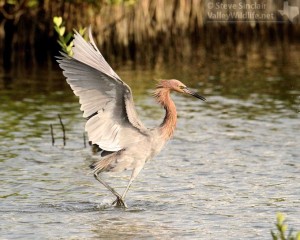I was back at South Padre Island the other day and although there weren’t so many small migrants present, as usual, the trip paid off with nice shots of Reddish Egrets and a few other animals. The Reddish Egret is the least common heron species in North America. While most species of herons and egrets are fairly easy to see at wetlands and marshes in many parts of the country, the elegant Reddish Egret is far more localized.
In the USA, this large heron mostly occurs in shallow estuaries and lagoons in coastal areas of Texas and south Florida. The Texas gulf coast is one of the best places to see this uncommon species, especially around South Padre Island.
The Reddish Egret comes in two morphs, one that is dark like the bird in these images, and one that is white. Both morphs can be recognized by the bicolored bill with a pink base, and dark legs.
One of the other large heron species at South Padre is the Great Blue Heron. Unlike the Reddish Egret, this big bird is one of the most common heron species in North America and occurs in a variety of wetland habitats.
Although there weren’t too many warblers around, I did manage to get a nice shot of a Northern Parula.
There were also butterflies in the area, including this beautiful Orange Julia.
I leave readers with another very close look at a mystery animal.
Is it a squirrel? Another jackrabbit? If you haven’t guessed what this animal is yet, take a close look at the eye. It’s the eye of a feline and the cat in question is a Bobcat.


